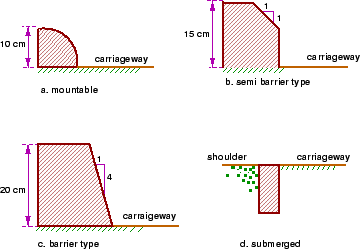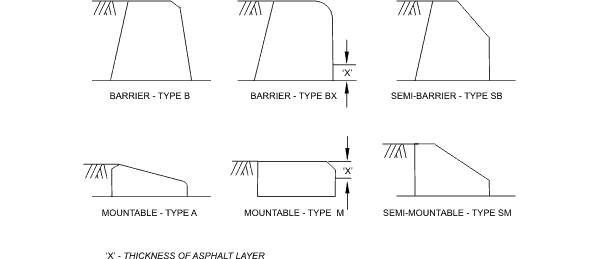|
Barrier kerbs are
steep-faced and are designed to prevent vehicle encroachment on the
roadside. Their main functions
are:
-
to discourage vehicles from using
areas outside the travelled way, not intended for vehicular
travel;
-
to control drainage;
-
to control parking of vehicles;
-
to reduce the risk to pedestrians.
The typical barrier kerb is 150mm high. This height is effective to
prevent vehicle encroachment into the roadside at low to moderate
speeds.
Barrier and semi-barrier kerbing should
generally be avoided on freeways or highways with design speeds of
over 70 km/h because impact with kerbing on high-speed roads may
overturn a vehicle or result in a vehicle becoming airborne.
Barrier-type kerbs may be used on sections of
road where separation of opposing traffic is essential due to the
high safety risks associated with traffic volumes, percentage of
heavy vehicles, speed, crash history etc.
If a design allows for kerbed shoulders with
barrier type kerbing the shoulder width should be adequate to
accommodate a disabled vehicle (eg. AASHTO recommends a min of 1.8m;
Austroads recommends a minimum width of 2.0m). The desirable
shoulder widths for rural and outer urban roads are shown in Main
Roads Supplement to Austroads GRD Part 3: Geometric Design - Table
4.3.
Barrier kerb, if positioned along the edge of
a traffic lane, gives drivers a sense of restriction. Also large
vehicles travelling along kerbed carriageways have no additional
space in which to manoeuvre or to allow for sway of the rear
trailer. It is recommended to avoid this type of kerbing on roads
with restricted lane width and high percentage of heavy vehicles.
Barrier kerbs reduce the risk to pedestrians,
not only as a physical but psychological barrier as well, because
drivers generally tend to shy away from the kerb line. For this
reason, barrier kerbing is recommended in built-up areas adjacent to
footpaths with considerable pedestrian traffic, shared use paths and
also at bus bays.
Barrier-type kerb may be used on low speed (< 70
km/h) arterial roads in order to prevent mid-block turns.
Some of the above text was adopted from
AASHTO's Policy on Geometric Design of Highways and Streets (2004). |




